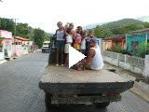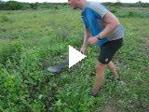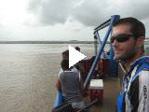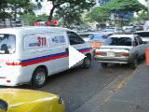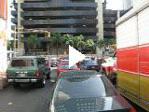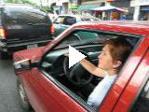I crossed the Venezuela border, climbing into the Andes again and to the town of San Cristobal, where I stayed at the fire station for the night. Crossing into Venezuela, I was immediately struck by the number of cars — Venezuela has the world’s 7th largest oil reserves, and it uses this oil wealth to keep gas prices low. Gas costs 15 cents a gallon, and the cities are full of cars, many of which are old U.S. cars with poor gas mileage.
Oil is a huge part of the Venezuelan economy, and I have entered the country with a very simple question: is this oil wealth good or bad for the people of Venezuela?
Because I had lost a week of travel to being sick, I could no longer make it to Caracas on time to meet a friend who was flying into town. Promising myself that I would use this method of travel only for traveling north to Caracas, I stuck out my thumb and hoped for friendly trucks.
Half biking and half hitching, I traveled north to northern Lago Maracaibo (see map), where I spent 3 days biking around the northern edge of the lake. The shallow lake, which is connected to the sea and thus not a true lake, is covered by thousands of oil wells, and the area produces a million barrels of oil a day. I camped one night next to a family that lives in a small community with oil rigs off shore. The father of the family worked on the oil rig, yet the rest of the people in the town, which was very poor, lived off of fishing. The man, of course, said that oil was good for the country, and also cited a series of new government programs that use the oil wealth to provide the village with health care and education.
As often happens in these small towns, a family feeds me and then stands around staring at me.
Continuing on, I biked to the city of Maracaibo, where I was interviewed by the local paper (La Panorama) and stayed with the Bomberos. I continued to be struck by how central the car is to Venezuelan society, and how much space in the cities is taken by car traffic.
My final day around Lake Maracaibo, I biked along the northeast edge, where many oil rigs could be seen offshore. The cities along the shore were not pleasant places, and I was stopped once while biking down a street because I was told that I would get robbed. So much oil had been extracted from the ground that the city Ciudad Ojeda has actually sunk 6 meters and a levy had to be built to keep out the lake water. I spent the night with two engineers who work in the oil industry and had seen me in the newspaper.
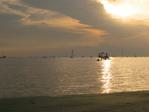
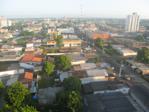
The couple (who also pointed out that oil companies can help sequester carbon) have drilled for oil in many places around the world and were adamant that it is bad for a place to discover oil. ‘I have seen villages in Africa where the people abandon their farming to work in oil, and then when the oil field dries up, they are unable to return to their old work.’ The city where they currently worked, Ciudad Ojeda, was a very unpleasant place — oil wealth apparently gives little incentive to invest in education or local infrastructure.
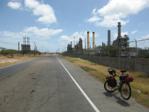
From Lake Maracaibo, I hitched along the coast to Punto Fijo, where Venezuela’s largest oil refinery is located. I tried to ask the guard questions about the refinery, but he yelled at me to go away, as all information was confidential, and he also told me not to take any pictures. From the people I talked to while hitchhiking to the refinery, most said that the oil did not help Venezuela at all, which was interesting. One man, a carpenter, complained ‘before the refinery was built, the locals drank, smoke, and womanized. Now they have money, so they drink, smoke, and womanize more. You can’t just have money — you need to educate people.’
After six days of half hitching and half biking, I arrived in Caracas. Hitching with a bike turned out to be very easy — I caught 17 different rides, and my longest wait was 45 minutes. To be sure, my method was foolproof — bike to the tool booth, show the police the newspaper article about my trip, and ask them to help me ask drivers of pickup trucks. But, even on the open road, my average wait was only 20 minutes.





